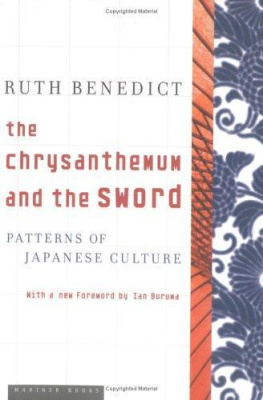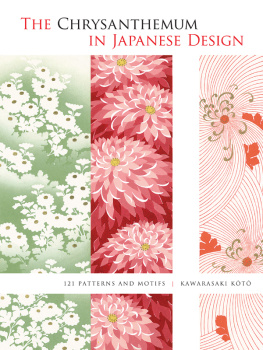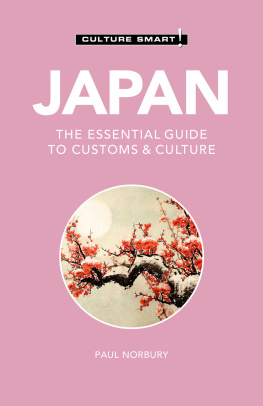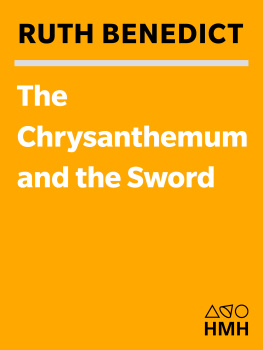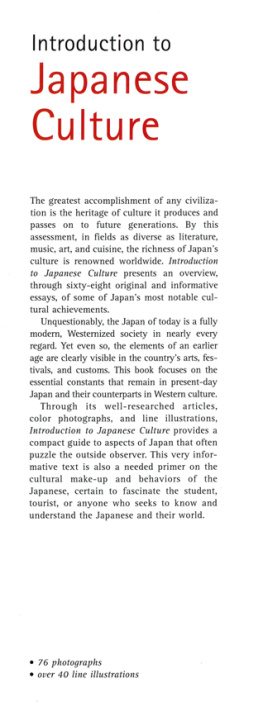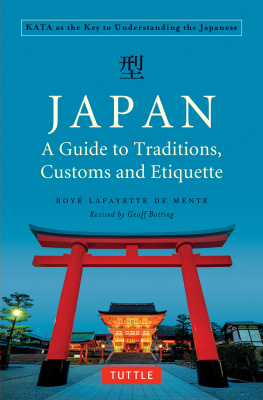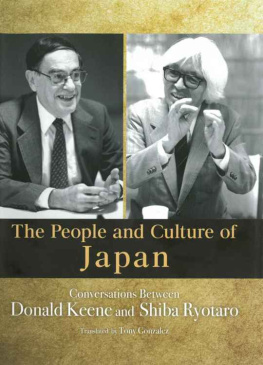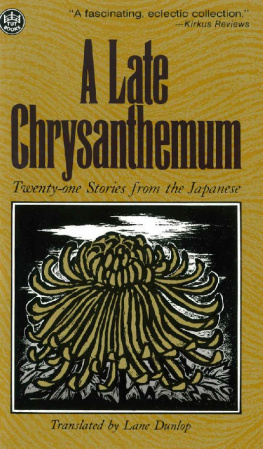Ruth Benedict - The Chrysanthemum and the Sword
Here you can read online Ruth Benedict - The Chrysanthemum and the Sword full text of the book (entire story) in english for free. Download pdf and epub, get meaning, cover and reviews about this ebook. year: 2006, publisher: Mariner Books, genre: History. Description of the work, (preface) as well as reviews are available. Best literature library LitArk.com created for fans of good reading and offers a wide selection of genres:
Romance novel
Science fiction
Adventure
Detective
Science
History
Home and family
Prose
Art
Politics
Computer
Non-fiction
Religion
Business
Children
Humor
Choose a favorite category and find really read worthwhile books. Enjoy immersion in the world of imagination, feel the emotions of the characters or learn something new for yourself, make an fascinating discovery.
- Book:The Chrysanthemum and the Sword
- Author:
- Publisher:Mariner Books
- Genre:
- Year:2006
- Rating:3 / 5
- Favourites:Add to favourites
- Your mark:
- 60
- 1
- 2
- 3
- 4
- 5
The Chrysanthemum and the Sword: summary, description and annotation
We offer to read an annotation, description, summary or preface (depends on what the author of the book "The Chrysanthemum and the Sword" wrote himself). If you haven't found the necessary information about the book — write in the comments, we will try to find it.
The Chrysanthemum and the Sword — read online for free the complete book (whole text) full work
Below is the text of the book, divided by pages. System saving the place of the last page read, allows you to conveniently read the book "The Chrysanthemum and the Sword" online for free, without having to search again every time where you left off. Put a bookmark, and you can go to the page where you finished reading at any time.
Font size:
Interval:
Bookmark:
Copyright (c) 1946 by Ruth Benedict
Copyright renewed (c) 1974 by Donald G. Freeman
Foreword copyright (c) 1989 by Ezra F. Vogel
All rights reserved
For information about permission to reproduce selections from this book, write to Permissions, Houghton Mifflin Company, 2 Park Street, Boston, Massachusetts 02108.
Library of Congress Cataloging-in-Publication Data
Benedict, Ruth, 18871948.
The chrysanthemum and the sword.
Reprint. Originally published: Cleveland: Meridian Books, 1967.
Includes index.
1. JapanCivilization. 2. National characteristics, Japanese. I. Title.
DS821.B46 1989 952 88-34818
ISBN 0-395-50075-3
Printed in the United States of America
VB 11 10
The author wishes to thank the publishers who have given her permission to quote from their publications: D. Appleton-Century Company, Inc., for permission to quote from Behind the Face of Japan, by Upton Close; Edward Arnold and Company for permission to quote from Japanese Buddhism, by Sir Charles Eliot; The John Day Company, Inc., for permission to quote from My Narrow Isle, by Sumie Mishima; J. M. Dent and Sons, Ltd., for permission to quote from Life and Thought of Japan, by Yoshisabura Okakura; Doubleday and Company for permission to quote from A Daughter of the Samurai, by Etsu Inagaki Sugimoto; Penguin Books, Inc., and the Infantry Journal for permission to quote from an article by Colonel Harold Doud in How the Jap Army Fights; Jarrolds Publishers (London), Ltd., for permission to quote from True Face of Japan, by K. Nohara; The Macmillan Company for permission to quote from Buddhist Sects of Japan, by E. Oberlin Steinilber, and from Japan: An Attempt at Interpretation, by Lafcadio Hearn; Rinehart and Company, Inc., for permission to quote from Japanese Nation, by John F. Embree; and The University of Chicago Press for permission to quote from Suye Mura, by John F. Embree.
Houghton Mifflin Company paperback 1989
Acknowledgments
Japanese men and women who had been born or educated in Japan and who were living in the United States during the war years were placed in a most difficult position. They were distrusted by many Americans. I take special pleasure, therefore, in testifying to their help and kindness during the time when I was gathering the material for this book. My thanks are due them in very special measure. I am especially grateful to my wartime colleague, Robert Hashima. Born in this country, brought up in Japan, he chose to return to the United States in 1941. He was interned in a War Relocation Camp, and I met him when he came to Washington to work in the war agencies of the United States.
My thanks are also due to the Office of War Information, which gave me the assignment on which I report in this book, and especially to Professor George E. Taylor, Deputy Director for the Far East, and to Commander Alexander H. Leighton, MC-USNR, who headed the Foreign Morale Analysis Division.
I wish to thank also those who have read this book in whole or in part: Commander Leighton, Professor Clyde Kluckhohn and Dr. Nathan Leites, all of whom were in the Office of War Information during the time I was working on Japan and who assisted in many ways; Professor Conrad Arensberg, Dr. Margaret Mead, Gregory Bateson and E. H. Norman. I am grateful to all of them for suggestions and help.
RUTH BENEDICT
Contents
Foreword
1. Assignment: Japan
2. The Japanese in the War
3. Taking One's Proper Station
4. The Meiji Reform
5. Debtor to the Ages and the World
6. Repaying One-Ten-Thousandth
7. The Repayment 'Hardest to Bear'
8. Clearing One's Name
9. The Circle of Human Feelings
10. The Dilemma of Virtue
11. Self-Discipline
12. The Child Learns
13. The Japanese Since VJ-Day
Glossary
Index
Text found on this page in the original book is not available for the netLibrary eBook edition.
Text found on this page in the original book is not available for the netLibrary eBook edition.
Text found on this page in the original book is not available for the netLibrary eBook edition.
Text found on this page in the original book is not available for the netLibrary eBook edition.
1
Assignment: Japan
The Japanese were the most alien enemy the United States had ever fought in an all-out struggle. In no other war with a major foe had it been necessary to take into account such exceedingly different habits of acting and thinking. Like Czarist Russia before us in 1905, we were fighting a nation fully armed and trained which did not belong to the Western cultural tradition. Conventions of war which Western nations had come to accept as facts of human nature obviously did not exist for the Japanese. It made the war in the Pacific more than a series of landings on island beaches, more than an unsurpassed problem of logistics. It made it a major problem in the nature of the enemy. We had to understand their behavior in order to cope with it.
The difficulties were great. During the past seventy-five years since Japan's closed doors were opened, the Japanese have been described in the most fantastic series of 'but also's' ever used for any nation of the world. When a serious observer is writing about peoples other than the Japanese and says they are unprecedentedly polite, he is not likely to add, 'But also insolent and overbearing.' When he says people of some nation are incomparably rigid in
their behavior, he does not add, 'But also they adapt themselves readily to extreme innovations.' When he says a people are submissive, he does not explain too that they are not easily amenable to control from above. When he says they are loyal and generous, he does not declare, 'But also treacherous and spiteful.' When he says they are genuinely brave, he does not expatiate on their timidity. When he says they act out of concern for others' opinions, he does not then go on to tell that they have a truly terrifying conscience. When he describes robot-like discipline in their Army, he does not continue by describing the way the soldiers in that Army take the bit in their own teeth even to the point of insubordination. When he describes a people who devote themselves with passion to Western learning, he does not also enlarge on their fervid conservatism. When he writes a book on a nation with a popular cult of aestheticism which gives high honor to actors and to artists and lavishes art upon the cultivation of chrysanthemums, that book does not ordinarily have to be supplemented by another which is devoted to the cult of the sword and the top prestige of the warrior.
All these contradictions, however, are the warp and woof of books on Japan. They are true. Both the sword and the chrysanthemum are a part of the picture. The Japanese are, to the highest degree, both aggressive and unaggressive, both militaristic and aesthetic, both insolent and polite, rigid and adaptable, submissive and resentful of being pushed around, loyal and treacherous, brave and timid, conservative and hospitable to new ways. They are terribly concerned about what other people will think of their behavior, and
they are also overcome by guilt when other people know nothing of their misstep. Their soldiers are disciplined to the hilt but are also insubordinate.
When it became so important for America to understand Japan, these contradictions and many others equally blatant could not be waved aside. Crises were facing us in quick succession. What would the Japanese do? Was capitulation possible without invasion? Should we bomb the Emperor's palace? What could we expect of Japanese prisoners of war? What should we say in our propaganda to Japanese troops and to the Japanese homeland which could save the lives of Americans and lessen Japanese determination to fight to the last man? There were violent disagreements among those who knew the Japanese best. When peace came, were the Japanese a people who would require perpetual martial law to keep them in order? Would our army have to prepare to fight desperate bitter-enders in every mountain fastness of Japan? Would there have to be a revolution in Japan after the order of the French Revolution or the Russian Revolution before international peace was possible? Who would lead it? Was the alternative the eradication of the Japanese? It made a great deal of difference what our judgments were.
Font size:
Interval:
Bookmark:
Similar books «The Chrysanthemum and the Sword»
Look at similar books to The Chrysanthemum and the Sword. We have selected literature similar in name and meaning in the hope of providing readers with more options to find new, interesting, not yet read works.
Discussion, reviews of the book The Chrysanthemum and the Sword and just readers' own opinions. Leave your comments, write what you think about the work, its meaning or the main characters. Specify what exactly you liked and what you didn't like, and why you think so.

